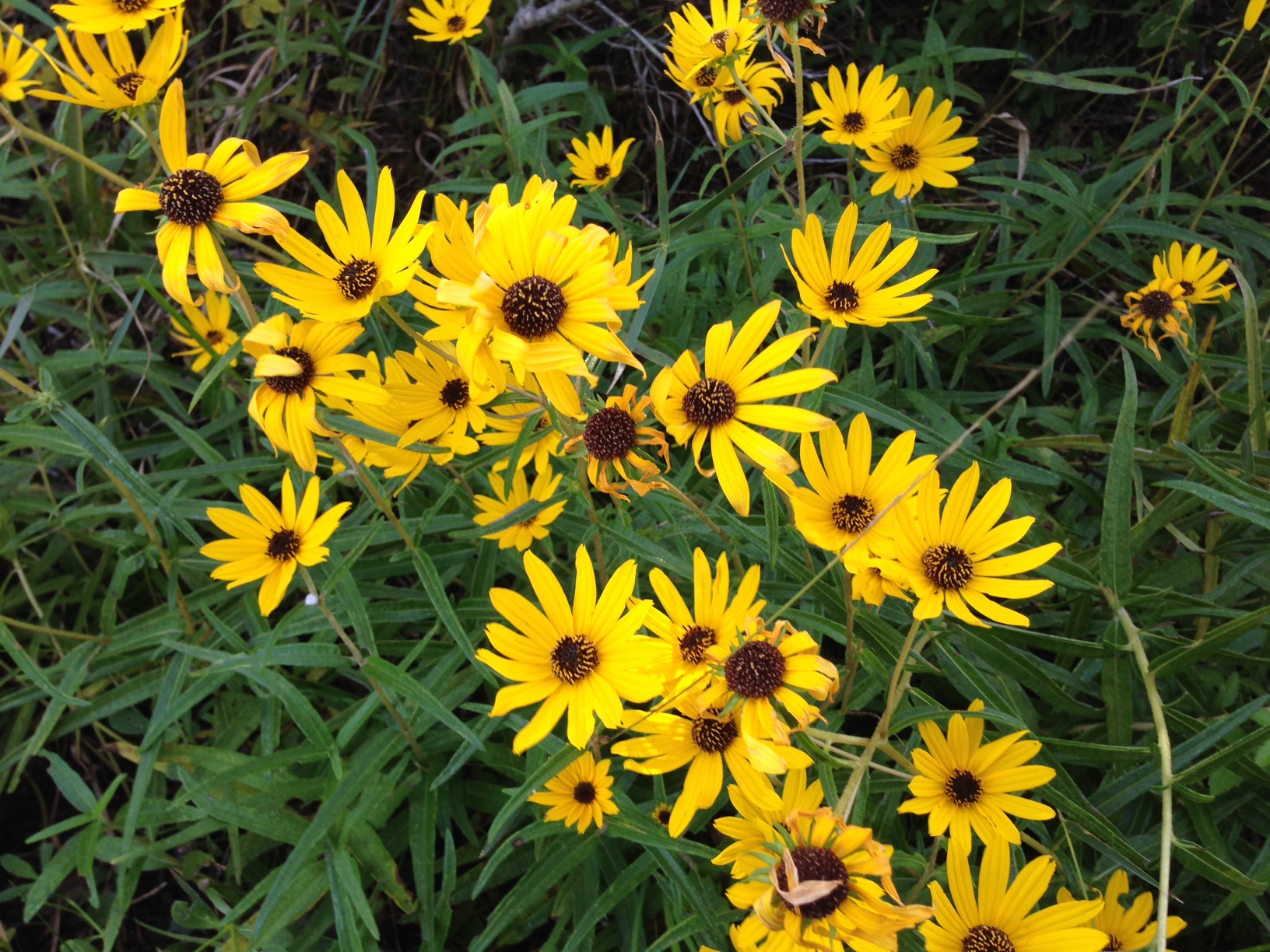
by Mary Salinas | Sep 23, 2014
In the midst of your September strolls through natural Florida, you may come across this native beauty, the narrowleaf sunflower, Helianthus angustifolius. Another common name is swamp sunflower. I found this gorgeous patch in the photo close to the shore of Apalachicola Bay. It occurs throughout Florida and north throughout much of the eastern United States. Florida is fortunate to be home to over 20 native species of sunflower.
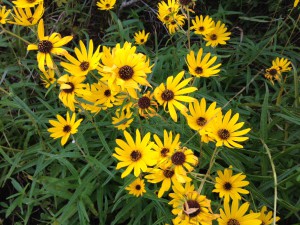
Narrowleaf Sunflower. Photo credit: Mary Derrick, UF/IFAS Extension.
This perennial starts blooming in late summer and dazzles admirers throughout autumn. The 2 to 3 inch flowers with bright yellow petals and brown centers are attractive to butterflies and other pollinators. What a great addition to your butterfly garden!
Plants generally grow to about 2 foot tall but they can grow a bit leggy to 6 foot. If desired, keep them more compact through pruning in late spring. Clumps can be divided every few years to spread them out or to share with friends and neighbors.
Like all sunflowers, it loves full sun but can tolerate some light shade. Narrowleaf sunflower is salt and flood tolerant and will do well in most soil types, however it does best in consistently moist conditions.
Narrowleaf sunflower plants may be difficult to find in the nursery trade but they can be readily started from seed.
For more information and seed sources:
Florida Wildflower Foundation
Atlas of Florida Vascular Plants: Helianthus species
Common Native Wildflowers of North Florida
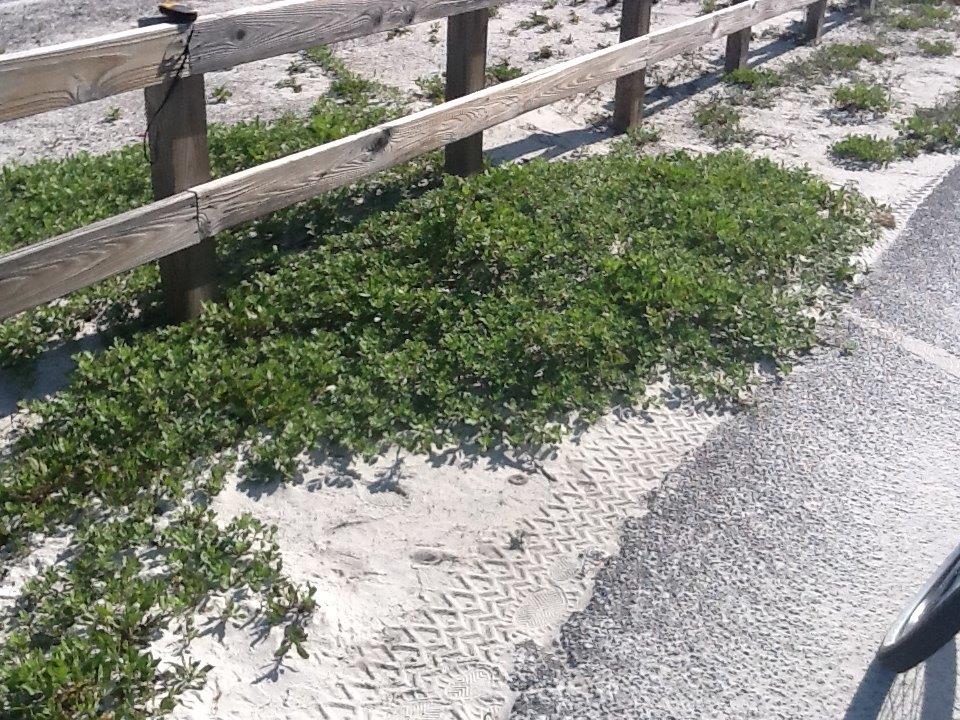
by Carrie Stevenson | Jul 21, 2014
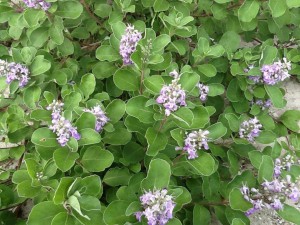
Many beachfront dwellers have intentionally planted beach vitex because of its attractive purple flowers. Photo credit: Rick O’Connor
Now that summer is in full swing, many of us are spending more time on our gorgeous Gulf beaches. Sea turtles are nesting and everyone gets excited at sightings of dolphins, sharks, and the Blue Angels. However, we have another recent visitor to our beaches, and this one isn’t spending money and renting condos. It has moved in from out-of-state and plans to stay, potentially wreaking havoc to our fragile beach dune ecosystems.
Florida is no stranger to invasive species. Reports and stories of pythons, popcorn trees, feral pigs, and others can be found everywhere. As a matter of fact, Florida and Hawaii have more problems with exotic plants and animals than any of the other states.
Beach Vitex (Vitex rotundifolia) is originally from the coastal areas of the western Pacific. It was brought to the United States by North Carolina State University in the 1980’s to restore dunes along coastal Carolina after severe storms. The plant is very salt and drought tolerant and performs well in direct sun and sandy soils; perfect for our coastal beaches. It grows about 3 feet tall and produces branches that extend along the surface of the sand over 60 feet from the tap-root. The flowers are lavender and found in the spring. By midsummer the flowers have dropped and pea-size dark fruit is produced. The fruit is also salt tolerant and can be carried by ocean currents as well as birds. The plant seemed a perfect choice for restoration projects.
And then…
And then it began to overgrow the primary dune system, choking the majority of the native plants including sea oats. The shrub size of the plant and the presence of vertical tap roots in lieu of fibrous ones did not suit it well as a dune forming plant; some studies found that it actually increased the erosion of some dune fields. Beach vitex releases allelopathic compounds, reducing the water content of the soil which stresses native plants thus reducing competition for space. And then there are the sea turtles. Evidence indicates that the growth of this plant over the primary dunes has made it difficult for female turtles to find nesting areas, while fast growing branches grow over incubating nests and make it difficult, if not impossible, for the hatchlings to emerge. The plant has become such a problem that it has been dubbed “Beach Kudzu” and there is a two-state task force to remove it.
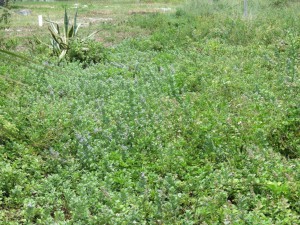
Beach vitex grows quickly and can rapidly take over an entire yard or beach dune. Photo credit: Rick O’Connor
Beach vitex has dispersed north to Virginia and south into Georgia. Currently it has been reported in only three Florida counties; Duval, Santa Rosa, and Escambia. Because of the few records in our state it is not currently listed as an invasive plant in Florida. The problem is, most biologists will tell you that the best way to eradicate an invasive species is to get it early. However most do not see the introduction of a new plant or animal as invasive until it becomes established and difficult to remove.
Natural Resource Agents with UF IFAS Extension are tracking the locations along the coast of the panhandle where this plant may exist. If you believe you may have it please let us know so that the location can be recorded. If you are interested in removing the plant we recommend cutting back to the tap-root. Dab the remaining tap-root with Round-Up. It is best if the remaining parts of the plant do not leave the property; if legal it is ok to burn. If you must transport it off the property we recommend it be dried on concrete and then double bagged before removing to the landfill. In many cases it may take several years to completely remove this plant. If you have any questions about this plant please call your local county Extension Office. Special thanks to Sea Grant Agent Rick O’Connor roc1@ufl.edu for use of this article.
by Larry Williams | Jul 15, 2014
Florida Betony (Stachys floridana), commonly called rattlesnake weed, is a Florida native plant. It’s thought to have been confined to Florida until it was moved to other Southeastern states during the 1940s or 1950s in nursery containers. It is now found from Texas to North Carolina. Its square stems are characteristic of the mint family of which it is a member.

Florida Betony foliage & flowers Photo Credits: UF/IFAS Extension
Underground white, fleshy tubers, which resemble a rattlesnake’s rattle in shape, provide the main means of reproduction. Pinkish-purple flowers are followed by a dried fruit that splits open releasing tiny seeds, which are a lesser means of reproduction. The white tubers have been used for hundreds of years as a starchy vegetable and are sometimes boiled like peanuts.
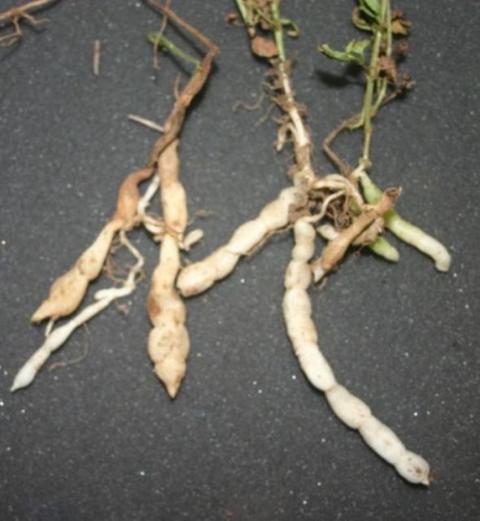
Florida betony weed tubers Photo Credits: UF/IFAS Extension
The tubers make Florida Betony tough to control. Even when above ground foliage and stems are killed due to herbicide use, the tubers allow the regeneration of the plant repeatedly. When attempting to control this weed, it helps to be more persistent than the plant. Many people give up.
Even though it is a perennial, the above-ground portion of the plant grows during fall and spring and becomes dormant during hotter weather.
You can remove the weed by digging, making sure to remove the entire root system (including the tubers). But persistence and patience is required. Herbicide control usually involves repeat applications approved products in lawns. Glyphosate herbicides such as Roundup can be used to control Florida Betony in plant beds. But do not get the herbicide on any green portion of desirable ornamentals.
Always refer to the product’s label for specific uses, application rates and turfgrass tolerance when using any herbicide.
So, why not just dig up the Florida Betony in your lawn and have a native plant feast?
by Larry Williams with content by Matthew Orwat
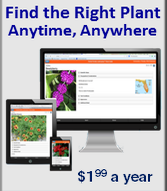
by Mary Salinas | Jul 15, 2014
We all seem to have this dilemma: A desire to re-landscape or just add a few plants to an area, but not knowing what would be the best choice. Plants need to be compatible with their location. The right plant should be chosen for the right place. Many have particular light, moisture and zone requirements in order to do their best. The ultimate size of the plant is also an important consideration; if you want to avoid constant pruning, choose plants that only grow to size you would like to ultimately have. Some great resources are provided below to get you the information you need.
 UF IFAS Extension has a brand new app for your mobile device or web! The app contains a database of over 400 Florida-friendly plants is searchable by plant name, type, shape, native status, light requirements and more. The yearly subscription is only $1.99 to have great info on the go.
UF IFAS Extension has a brand new app for your mobile device or web! The app contains a database of over 400 Florida-friendly plants is searchable by plant name, type, shape, native status, light requirements and more. The yearly subscription is only $1.99 to have great info on the go.
The downloadable 104-page Florida-friendly Landscaping Guide to Landscape Design and Plant Selection not only has photos and detailed information about plants by category, it also has great ideas on how to improve your landscape design! 
UF’s Florida Yards & Neighborhoods maintains a searchable Florida-friendly Plant Database. Make choices based on region, plant type, light and moisture quantity, soil texture salt tolerance.
For native plants, the Florida Association of Native Nurseries has two websites where you can find plants for your particular zone, plant community (like at the beach or in pine flatwoods), plant type and by wildlife usage. There is a site designed for nursery professionals that lets you find local wholesale growers and also a similar site for homeowners that has resources on where to find desired plants at local nurseries.
Speaking of native plants, the Florida Native Plant Society also has a searchable list of plants appropriate for your particular needs.
Gardening Solutions has lots of great information for lawn, landscape and garden by category, and it is easily accessed.
Happy Gardening!
by Taylor Vandiver | Jul 1, 2014
The summertime often reminds us of our uninhibited spirit. With Independence Day not far off, Floridians will be celebrating the freedom of our nation while battling the oppressive climate you can’t seem to escape this time of year. As we approach the apex of heat and humidity here in Florida, we would do well to remember the tenacity of our native wildflowers and their “spirited” survival of Florida’s extreme conditions.

Coreopsis flowers. Photo courtesy UF/IFAS.
Historically, Florida’s landscape was alive with color throughout the seasons. Through urbanization and cultivation we’ve lost a large part of that legacy; however, we can reestablish some of Florida’s colorful past in our own yards and neighborhoods.
In order to ensure successful planting of wildflowers it is important to properly select and prepare your site. You will want to choose a sunny-well drained area and cut any existing vegetation to the ground. It may be beneficial to put down sheets of cardboard to smother what’s left of the vegetation. This is best done in the summer in advance of fall planting.
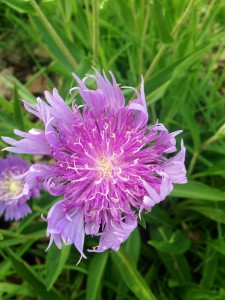
Stokes’ Aster in bloom.
Planting is best done late August to early September in North Florida. Soil-to-seed contact is critical so 1 day before seeding, or just prior to seeding, firmer soils need to be lightly scratched with a rake. Sandy soils might have to be made more firm to ensure that seed do not sink too deep. Broadcast the wildflower seeds at the recommended rate then press them into the soil by walking around on the planting site.
Wildflower seeds require adequate moisture during germination. After planting irrigate the site with about 1/4 to 1/2 inch of water daily for the first few weeks. After that, irrigate with about 1/2 inch water only if the wildflowers show signs of drought stress. Once established though, the meadow needs very little, if any, irrigation. Fertilizers should be avoided altogether as they promote the growth of aggressive weeds. Many of Florida’s native wildflower species are adapted to and perform well in soils with low fertility. Your wildflowers will re-send themselves if given the opportunity so wait until seed have matured before deadheading or mowing. Cut no lower than six to eight inches to avoid damaging the crowns of grasses and wildflowers.
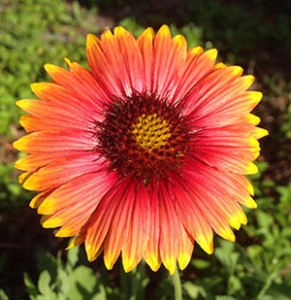
Native Gaillardia. Photo courtesy UF/IFAS.
To successfully cultivate a wildflower meadow in your home landscape, it’s helpful to select plants with the qualities to fit the conditions at your site. Also, consider blooming dates of flowers in order to provide color and interest for your landscape spring through fall. While not always possible, it’s best to purchase seeds and plants known to be Florida ecotypes. Consult with local nurseries and garden centers for more information on plant and seed availability and seeding rates. You can always contact your local Extension Office for more information. Other good sources of information are the Wildflower Seed And Plant Growers Association, Inc. (www.floridawildflowers.com); Association of Florida Native Nurseries (www.afnn.org); and the Florida Wildflower Foundation (www.floridawildflowerfoundation.org).
Growing wildflowers can restore a special sense of natural history close to home. So if you are looking for an “explosion” of color that will stand the test of time, Florida’s native wildflowers will not disappoint.

by Roy Carter | Jun 10, 2014

Blueberry. Photo credit: Eric Zamora, UF IFAS.
Blueberries are native to Eastern North America. They are one of the few crop plants that originated here. The rabbiteye blueberry occurs mostly in certain river valleys in Northern Florida and Southeastern Georgia. The high bush blueberry is native to the eastern third of the United States and Southeastern Canada. Florida is rich in other native species. The woods and swamps of Florida are populated with at least eight wild blueberry species. No area of the state lacks wild blueberries, except where soil pH is above 6.0.
The two types of blueberries grown in Florida are Southern highbush and rabbiteye. The earliest ripening southern highbush varieties ripen about 4 to 6 weeks earlier than the earliest rabbiteye varieties grown at the same location.
Some rabbiteye varieties recommended for our area are: Alice blue, Beckyblue, Climax, Bonita, Brightwell, Chaucer and Tifblue. Some recommended Southern Highbush varieties are: Blue Crisp, Gulf Coast, Jewel, Sharpblue, Santa Fe, Star and Misty.
Blueberries need a fairly acid soil; a pH range of 4 to 5 is suggested. Blueberries grown on alkaline or deep sands will grow poorly. If you need to lower the soil pH before planting, mix in some acidic peat moss.
Blueberries have a shallow, fibrous root system. That means plants should be placed in the ground about an inch deeper than they were growing in the nursery. Rabbiteye blueberries grow poorly in soils with excessive drainage. But they won’t tolerate too much moisture for long periods of time either.
Blueberries are very sensitive to fertilizers. During the first growing season, no mineral fertilizer should be added at all. In the second season, apply about two ounces of an acidic fertilizer per plant. Blueberries can use the same fertilizer as camellias and azaleas, but be careful not to overdo it. Excessive amounts of fertilizer will kill the plants.
Before planting blueberries, you should cultivate the soil by plowing or roto tilling to a depth of at least six inches. Dig a hole large enough so that the roots won’t be crowded. Lightly pack the soil around the roots and water thoroughly. Keep in mind that newly set plants need a good water supply.
Bare-root bushes should be transplanted during the winter months; container grown bushes can be transplanted anytime. The first year after planting, the blossoms should be removed to help the bush grow more quickly.
Pruning is an important part of blueberry culture. It promotes the growth of strong wood, and rids the tree of weak twiggy growth. The strong wood growth is necessary for good fruit production.
Believe it or not, the worst pests of blueberries are birds. You need to protect your bushes with some kind of netting, or employ the old fashioned scarecrow to do the job. It you don’t protect your bushes, you can count on the birds getting to the fruit before you do.
Other than birds, rabbiteye blueberries have few pest or disease problems. Powdery mildew can occur on bushes that don’t get full sun, but this problem can be easily controlled with a sulfur spray. Bud mites, thrips, fruitworms, and defoliating insects can sometimes be a problem.
Weeds will compete with young blueberry bushes for nutrients and water, so keep the beds as free of weeds as possible. Mulches are good for controlling weed growth. If necessary, there are herbicides available.
For more information please see:
Blueberry Gardener’s Guide













